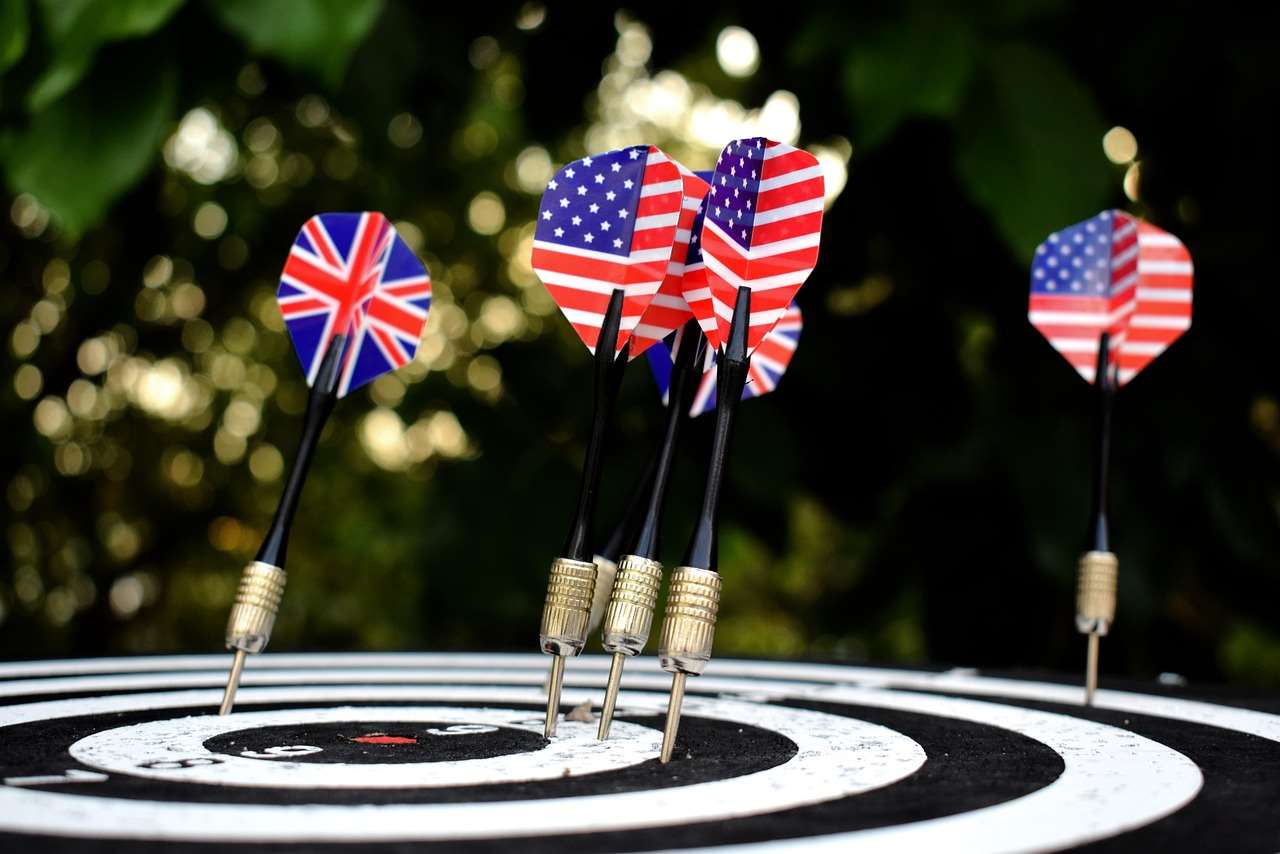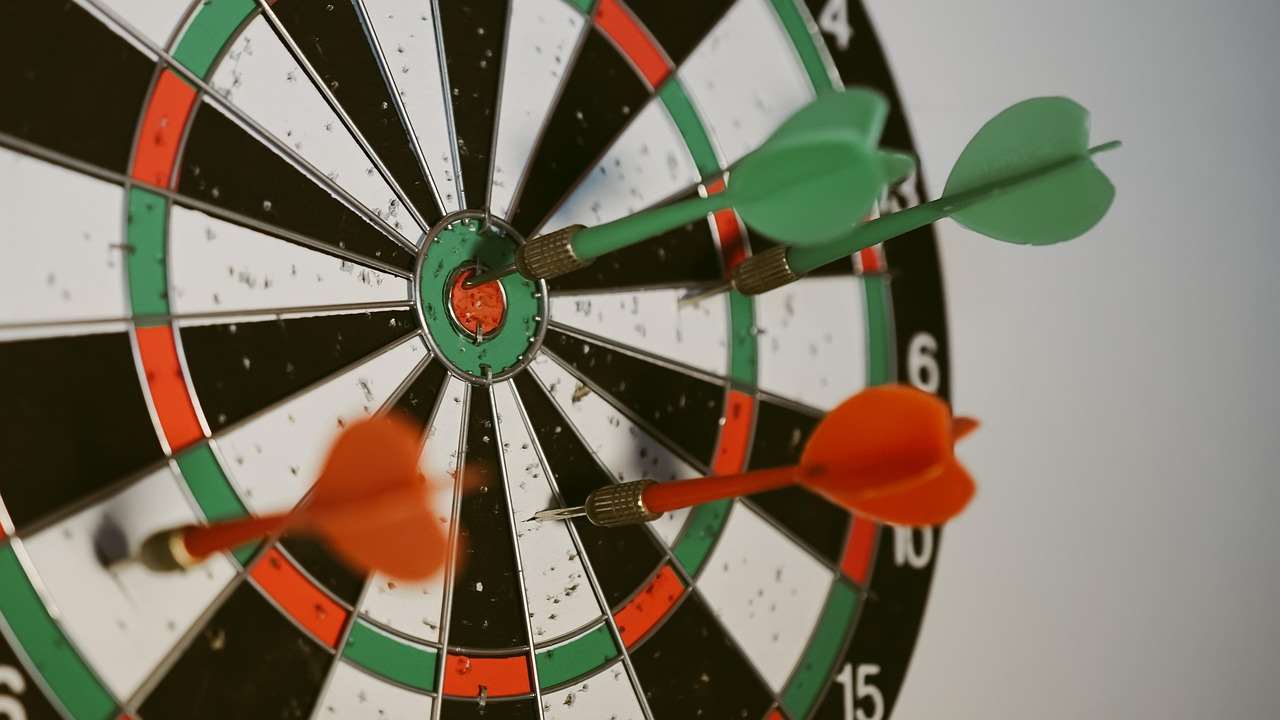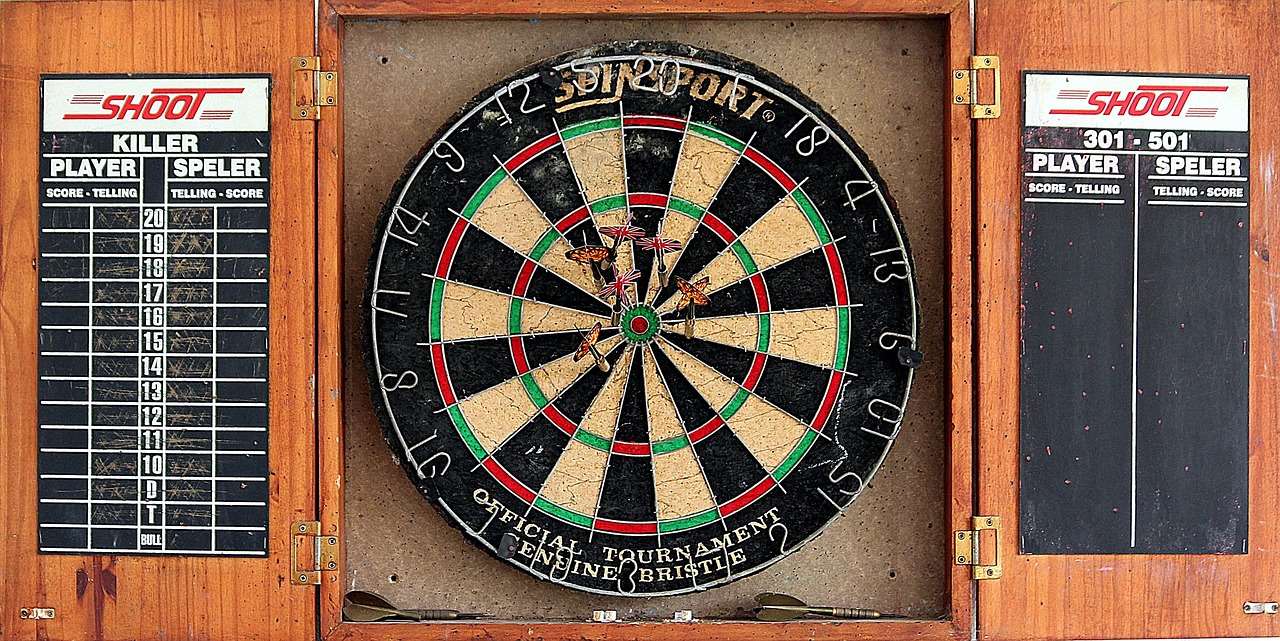The key to **how to shoot in darts** consistently lies in mastering a stable stance, a smooth throwing motion, and a focused release. This article will break down each element, guiding you from beginner basics to more advanced techniques, so you can improve your **dart throwing technique** and aim like a pro.
⚠️ Still Using Pen & Paper (or a Chalkboard)?! ⚠️
Step into the future! The Dart Counter App handles all the scoring, suggests checkouts, and tracks your stats automatically. It's easier than you think!
Try the Smart Dart Counter App FREE!Ready for an upgrade? Click above!
Mastering the Fundamentals: Stance, Grip, and Alignment
Before even thinking about **darts accuracy** or specific targets, you need to establish a solid foundation. This starts with your stance, grip, and alignment.
Finding Your Ideal Stance
Your stance is your base. A stable stance is crucial for consistency. Most players prefer one of three stances:
- Square Stance: Both feet are parallel to the oche (the throwing line). This provides maximum stability but can restrict upper body movement.
- Open Stance: One foot is slightly forward, angled towards the board. This allows for more upper body rotation and a smoother throw.
- Closed Stance: Similar to the open stance, but the front foot is positioned further forward.
Experiment to see which stance feels most natural and allows you to maintain balance. Keep your weight balanced, leaning slightly forward. Your front foot should be close to the oche, but not over it. Remember, **consistency** is key to **improving your darts game**.
The Perfect Grip: Comfort and Control
The **dart grip** is highly personal, and there’s no single “right” way. However, some general principles apply:
- Avoid gripping too tightly: A death grip will tense your muscles and negatively affect your throw. A relaxed grip allows for a smoother release.
- Use enough fingers for control: Most players use three or four fingers. Experiment to find what feels most secure.
- Consistent grip: Once you find a comfortable grip, stick with it. Changing your grip frequently will lead to inconsistency.
Consider the type of dart you’re using. A heavier dart might require a firmer grip. Ultimately, the best grip is one that feels natural and gives you consistent control of the dart. If you need a new dart board check out darts osrs for a new game.

Alignment: Sighting the Target
Proper alignment ensures you’re aiming at your target correctly. After you get your dart, follow these steps:
- Focus on your target: Keep your eyes locked on the segment you’re aiming for.
- Line up your throwing arm: Your elbow should be pointing towards the target.
- Maintain a consistent eye line: Try not to move your head during your throw.
Some players find it helpful to visualize a straight line from their eye, down their arm, and to the target. Small adjustments in your stance or grip can help you achieve proper alignment. Think of it as aiming a rifle – precision matters!
**How to Shoot in Darts**: The Throwing Motion
The throwing motion is where everything comes together. A smooth, controlled motion is essential for accuracy and consistency. Here’s a breakdown of the key elements:
The Backswing: Loading Up
The backswing is the preparation phase of your throw. It’s important to:
- Keep your elbow still: Your elbow should act as a hinge. Avoid excessive elbow movement.
- Pull the dart back smoothly: Avoid jerking or snapping the dart back.
- Find your anchor point: Most players bring the dart back to a consistent point near their face or chin. This helps with consistency.
The backswing should be a natural and fluid movement, setting you up for the forward motion.
The Forward Swing: Accelerating to Release
The forward swing is where you generate power and accuracy. Key points to focus on:
- Smooth acceleration: Gradually increase the speed of your arm as you move forward.
- Maintain a straight line: Keep your throwing arm moving in a straight line towards the target.
- Elbow extension: Fully extend your elbow as you release the dart.
Avoid “snapping” your wrist, as this can lead to inconsistent throws. The power should come from your arm and shoulder, not your wrist. Learn more about the rules with darts bullseye rules.

The Release: The Moment of Truth
The release is the most critical part of the throw. A clean, consistent release is essential for **darts precision**. Focus on:
- Releasing the dart smoothly: Let the dart roll off your fingertips.
- Follow through: Continue your arm motion after releasing the dart. This helps maintain a straight line and prevents you from “pulling” the dart.
- Consistent release point: Aim to release the dart at the same point in your swing each time.
Practicing your release is crucial. Try practicing in front of a mirror to analyze your technique and identify any inconsistencies. Also, you can use a Dart game scoring app to keep track of your game. Consider experimenting with **darts equipment** to find darts that suit your throwing style.
Fine-Tuning Your Aim: Adjustments and Strategies
Once you’ve mastered the fundamentals, you can start fine-tuning your aim and developing strategies for specific targets.
Making Small Adjustments
Even with perfect technique, you’ll sometimes miss your target. Learning **darts adjustments** is crucial. Common adjustments include:
- Slight stance adjustments: Moving your front foot slightly left or right can help compensate for lateral errors.
- Elbow adjustments: Minor adjustments to your elbow position can affect the vertical trajectory of the dart.
- Grip adjustments: Subtle changes to your grip can influence the dart’s angle of release.
Pay attention to where your darts are landing and make small, incremental adjustments to correct your aim. It’s a process of constant refinement.
Target Selection: Strategic Play
In addition to aiming, strategic target selection is key to **darts strategy**. Depending on the game you’re playing (e.g., 501, Cricket), choose your targets carefully. Common strategies include:
- Aiming for doubles: Doubles are crucial for finishing a game. Practice hitting specific doubles consistently.
- Setting up for outs: Plan your throws to leave yourself with a manageable checkout.
- Playing defensively: Sometimes, the best strategy is to prevent your opponent from scoring.
Understanding the game’s rules and developing a strategic approach can give you a significant advantage. Also, check out viper dart counter.

Mental Game: Focus and Confidence
Darts is a mental game as much as it is a physical one. Maintaining focus and confidence is crucial for consistent performance. Tips for improving your mental game:
- Visualize success: Before each throw, picture the dart hitting your target.
- Stay calm under pressure: Don’t let nerves get the best of you. Take deep breaths and focus on your technique.
- Learn from your mistakes: Don’t dwell on bad throws. Analyze what went wrong and focus on improving next time.
Developing a positive mental attitude can significantly improve your **darts performance**. Embrace the challenge and enjoy the process of improvement. If you need a good laugh, try some darts puns one liners for adults.
Common Mistakes to Avoid: Troubleshooting Your Throw
Even experienced players make mistakes. Identifying and correcting common errors is crucial for continuous improvement.
Inconsistent Grip
As mentioned earlier, a **consistent grip** is paramount. Avoid changing your grip frequently. If you notice your darts are flying erratically, your grip may be the culprit. Return to the fundamentals of finding the perfect grip and stick to it.
Elbow Movement
Excessive elbow movement is a common cause of inaccuracy. Your elbow should act as a hinge, with minimal side-to-side or up-and-down movement. Focus on keeping your elbow stable throughout your throw.
Wrist Snap
Snapping your wrist can add power to your throw, but it also makes it difficult to control the dart. Avoid using your wrist as the primary source of power. Instead, focus on using your arm and shoulder to generate a smooth, controlled throw.

Rushing Your Throw
Taking your time and focusing on your technique is essential. Rushing your throw can lead to sloppy mechanics and inaccurate darts. Take a deep breath, visualize your target, and execute your throw with control.
Not Following Through
Failing to follow through after releasing the dart can cause you to “pull” the dart or throw it off course. Make sure you fully extend your arm and continue your motion after releasing the dart. This helps maintain a straight line and improves accuracy.
Practice Drills to Improve Your Game
Consistent practice is the key to improving your **darts skills**. Incorporate these drills into your training routine:
Around the Clock
Start at the number 1 segment and work your way around the board, hitting each segment in order. This drill improves your accuracy and consistency on all parts of the board.
Doubles Practice
Focus specifically on hitting doubles. Start with the double 20 and work your way around the board. This drill is crucial for improving your finishing ability. This might require you to learn about double top darts code.

Checkout Drills
Practice specific checkouts, such as 40, 61, and 81. This will help you become more comfortable and confident when facing these situations in a game. Also, you can improve your performance by using target darts ultra marine.
High Score Practice
Focus on scoring as many points as possible in each turn. This drill will improve your overall scoring ability and help you become a more aggressive player.
Conclusion: Consistent Practice for Darts Mastery
**Learning how to shoot in darts** effectively is a journey that requires dedication and consistent practice. By mastering the fundamentals of stance, grip, and alignment, developing a smooth throwing motion, and fine-tuning your aim, you can significantly improve your game. Remember to avoid common mistakes, incorporate practice drills into your routine, and stay focused and confident. Now, grab your darts, practice these techniques, and watch your scores soar! Ready to take your game to the next level? Find a local darts league or tournament and put your skills to the test!
Hi, I’m Dieter, and I created Dartcounter (Dartcounterapp.com). My motivation wasn’t being a darts expert – quite the opposite! When I first started playing, I loved the game but found keeping accurate scores and tracking stats difficult and distracting.
I figured I couldn’t be the only one struggling with this. So, I decided to build a solution: an easy-to-use application that everyone, no matter their experience level, could use to manage scoring effortlessly.
My goal for Dartcounter was simple: let the app handle the numbers – the scoring, the averages, the stats, even checkout suggestions – so players could focus purely on their throw and enjoying the game. It began as a way to solve my own beginner’s problem, and I’m thrilled it has grown into a helpful tool for the wider darts community.